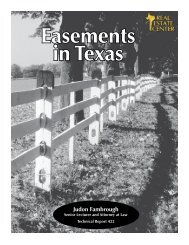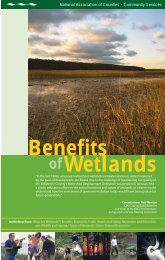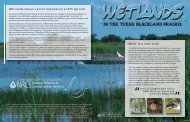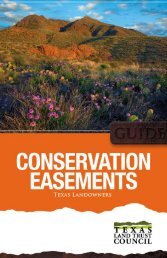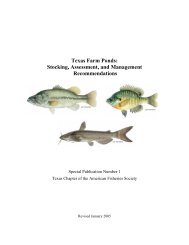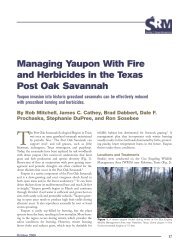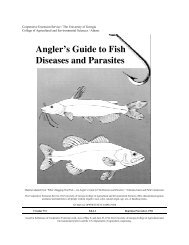Managing for Wood Ducks in East Texas - Trinity Waters
Managing for Wood Ducks in East Texas - Trinity Waters
Managing for Wood Ducks in East Texas - Trinity Waters
You also want an ePaper? Increase the reach of your titles
YUMPU automatically turns print PDFs into web optimized ePapers that Google loves.
service each year. Boxes should be placed <strong>in</strong> the open away from overhang<strong>in</strong>g<br />
limbs or v<strong>in</strong>es and clear of nearby bushes or other tall vegetation. Nest box<br />
holes should be faced toward the open wetland area so they are easily visible<br />
and accessible to approach<strong>in</strong>g wood ducks.<br />
The use of support poles is an important approach to locat<strong>in</strong>g nest boxes.<br />
Attach<strong>in</strong>g nest boxes to trees is not recommended. The use of support poles<br />
rather than trees is favored <strong>for</strong> two reasons: 1) with support poles, boxes can<br />
be placed where they have the best chance of be<strong>in</strong>g used by ducks, and, 2)<br />
effective predator barriers can be used on support poles. Research <strong>in</strong> <strong>Texas</strong> has<br />
shown that boxes adjacent open, herbaceous wetlands are most attractive to<br />
wood duck hens. Nationwide research has revealed that when several nest<strong>in</strong>g<br />
cavities can be seen simultaneously, hens may lay eggs <strong>in</strong> any or all of the boxes<br />
but not <strong>in</strong>cubate any of the eggs. Dump nest<strong>in</strong>g also tends to <strong>in</strong>crease <strong>in</strong> these<br />
situations. For this reason, we recommend visual separation among the nest<br />
boxes placed at any given wetland. Placement of boxes on trees limits reliable<br />
application of these techniques.<br />
NEST BOX INSTALLATION<br />
The tasks described <strong>in</strong> this section relate to assembl<strong>in</strong>g the nest<strong>in</strong>g units and<br />
gett<strong>in</strong>g them <strong>in</strong>stalled at the sites selected accord<strong>in</strong>g to the recommendations<br />
given above. (Note: We consider a "nest<strong>in</strong>g unit" to be: 1) a nest box,<br />
2) a support pole, and 3) a predator barrier.)<br />
FIGURE 5<br />
Ideal Brood<br />
Rear<strong>in</strong>g Habitat<br />
Obviously, a variety of supports exist. You already may have suitable posts<br />
or pipe available to use as support poles. However, if purchase is necessary,<br />
heavy-wall electrical conduit tub<strong>in</strong>g is a suitable material <strong>for</strong> support poles. We<br />
recommend 10-foot lengths <strong>in</strong> 1-<strong>in</strong>ch diameter. The best attachment is by 1/4 x<br />
2 <strong>in</strong>ch bolts. Be sure to place a flat washer aga<strong>in</strong>st the bolt head and a flat<br />
washer/lock-washer comb<strong>in</strong>ation beh<strong>in</strong>d the nut. <strong>Wood</strong>en poles also are<br />
acceptable. When nails are used to attach the boxes to wooden posts, a flat<br />
washer should be placed aga<strong>in</strong>st the nail heads. <strong>Wood</strong>en posts should be<br />
pressure-treated with wood preservative (e.g. "Wolmanized"). These posts<br />
should be 10 feet <strong>in</strong> length and three to four <strong>in</strong>ches <strong>in</strong> diameter. Pressuretreated<br />
two-by-fours <strong>in</strong> 10-foot lengths have been used. With two-by-fours,<br />
braces may be needed to prevent warp<strong>in</strong>g. Postholes should be 1 1 / 2 to 2 feet <strong>in</strong><br />
depth. <strong>Wood</strong>en stakes may be driven beside posts to stabilize them <strong>in</strong><br />
waterlogged soils. Nest boxes should be nailed <strong>in</strong> place be<strong>for</strong>e the posts are<br />
dropped <strong>in</strong>to the holes.<br />
14<br />
MANAGING FOR WOOD DUCKS IN EAST TEXAS



